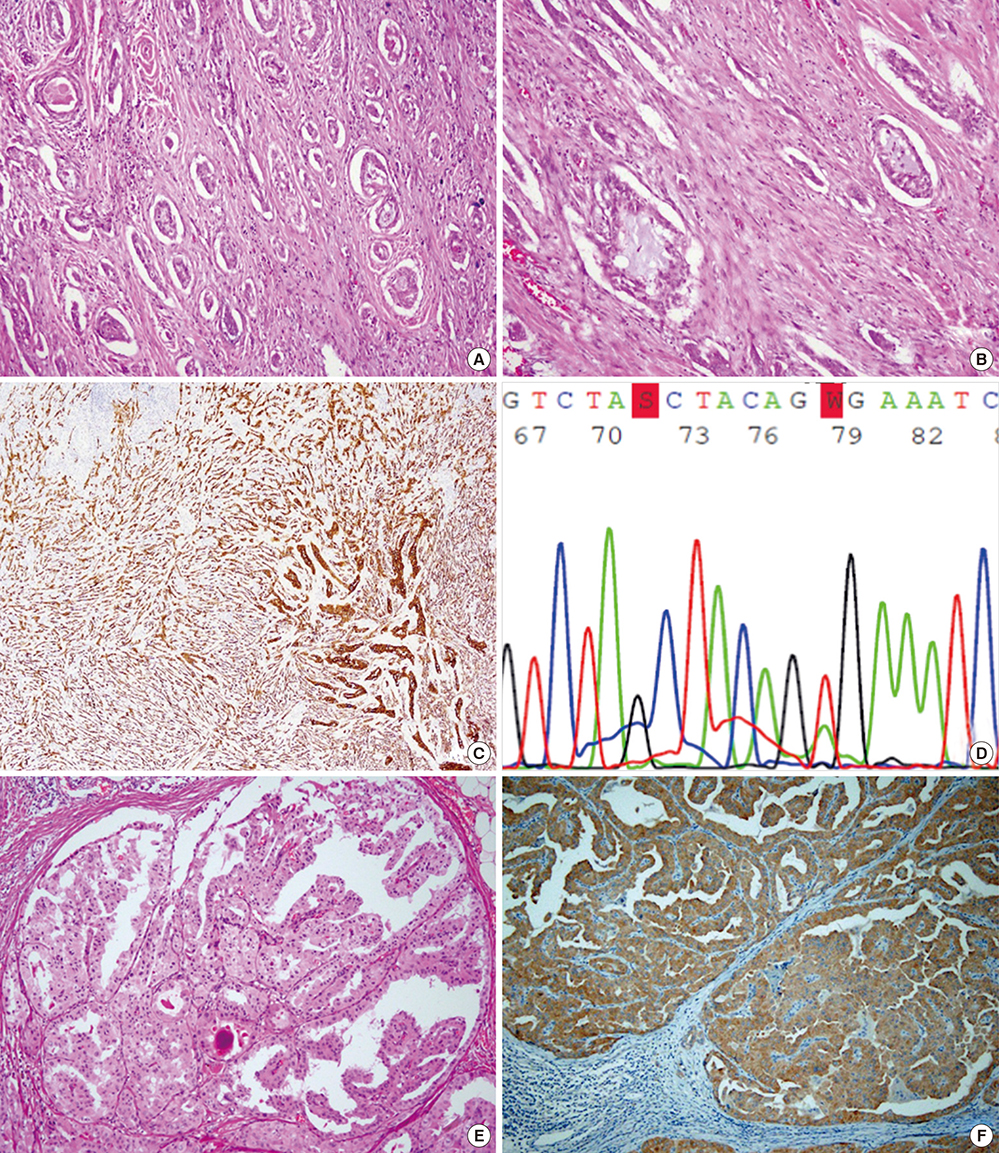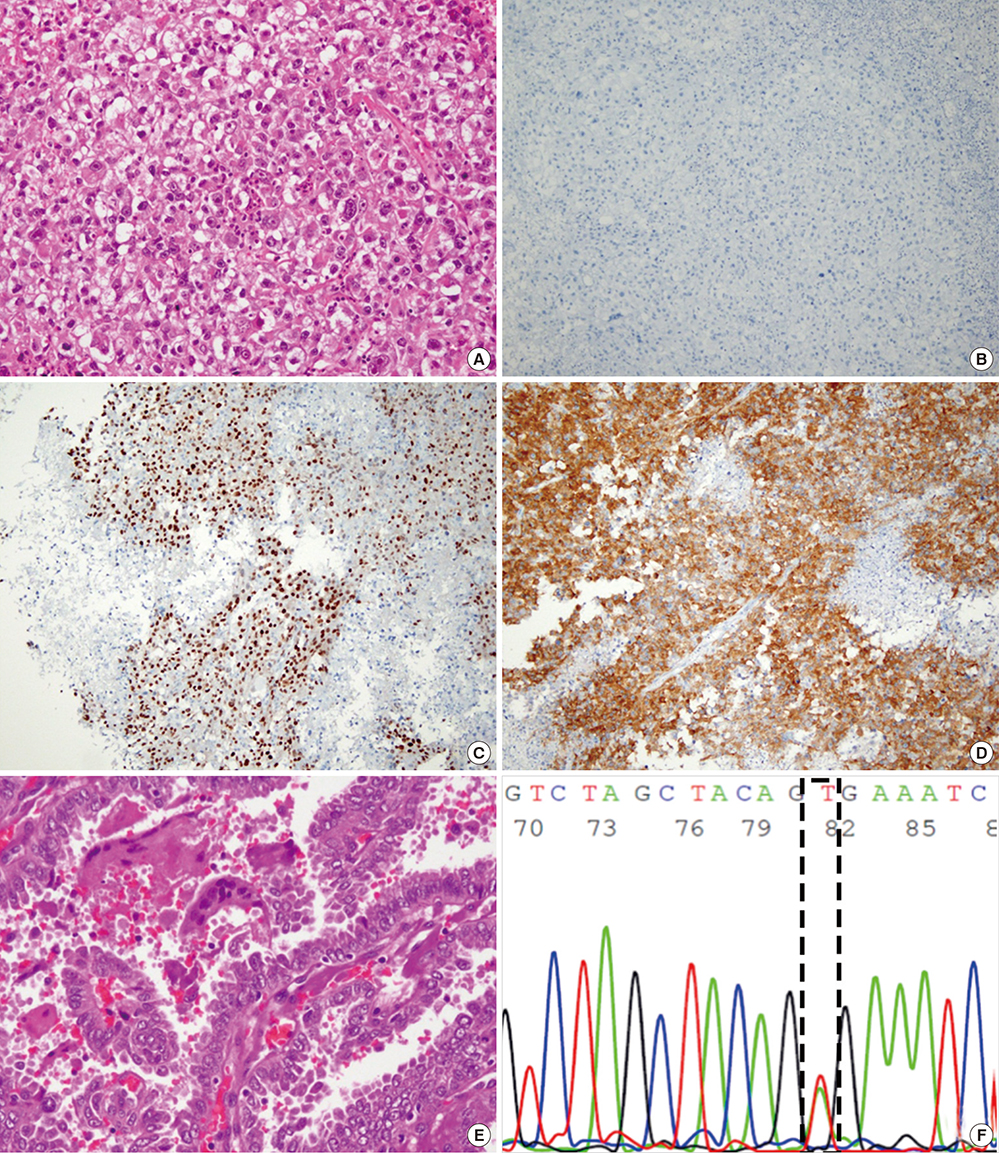J Korean Med Sci.
2017 Oct;32(10):1721-1726. 10.3346/jkms.2017.32.10.1721.
Rare Manifestations of Anaplastic Thyroid Carcinoma: the Role of BRAF Mutation Analysis
- Affiliations
-
- 1Department of Internal Medicine, Seoul National University Hospital, Seoul National University College of Medicine, Seoul, Korea.
- 2Department of Pathology, Seoul St. Mary's Hospital, The Catholic University of Korea College of Medicine, Seoul, Korea.
- 3Department of Pathology, Seoul National University Hospital, Seoul National University College of Medicine, Seoul, Korea. jkyung.won@gmail.com
- KMID: 2400449
- DOI: http://doi.org/10.3346/jkms.2017.32.10.1721
Abstract
- Anaplastic thyroid carcinoma (ATC) is difficult to distinguish from other cancers, especially when its pathological features are atypical for ATC or when the tumor is totally undifferentiated and occurs after a considerable lapse of time, in an area remote from the original site of the tumor. Here, we present two patients (68-year-old man and 56-year-old woman) with rare manifestations of ATC, which were initially thought to be other malignancies. Immunohistochemical tests, using various markers, failed to provide information about the origin of these tumors. However, both patients had a history of papillary thyroid carcinoma (PTC) from several years ago and BRAF mutations were observed in the undifferentiated tumors, as well as in the previous PTCs. Therefore, we could make a diagnosis of ATC derived from PTC. As such, BRAF mutation analysis may serve as a useful tool for ATC diagnosis in challenging ATC cases.
MeSH Terms
Figure
Reference
-
1. Nagaiah G, Hossain A, Mooney CJ, Parmentier J, Remick SC. Anaplastic thyroid cancer: a review of epidemiology, pathogenesis, and treatment. J Oncol. 2011; 2011:542358.2. Goutas N, Vlachodimitropoulos D, Bouka M, Lazaris AC, Nasioulas G, Gazouli M. BRAF and K-RAS mutation in a Greek papillary and medullary thyroid carcinoma cohort. Anticancer Res. 2008; 28:305–308.3. Kim SK, Song KH, Lim SD, Lim YC, Yoo YB, Kim JS, Hwang TS. Clinical and pathological features and the BRAF (V600E) mutation in patients with papillary thyroid carcinoma with and without concurrent Hashimoto thyroiditis. Thyroid. 2009; 19:137–141.4. Nikiforova MN, Kimura ET, Gandhi M, Biddinger PW, Knauf JA, Basolo F, Zhu Z, Giannini R, Salvatore G, Fusco A, et al. BRAF mutations in thyroid tumors are restricted to papillary carcinomas and anaplastic or poorly differentiated carcinomas arising from papillary carcinomas. J Clin Endocrinol Metab. 2003; 88:5399–5404.5. Carcangiu ML, Steeper T, Zampi G, Rosai J. Anaplastic thyroid carcinoma. A study of 70 cases. Am J Clin Pathol. 1985; 83:135–158.6. Rosai J, Saxén EA, Woolner L. Undifferentiated and poorly differentiated carcinoma. Semin Diagn Pathol. 1985; 2:123–136.7. Venkatesh YS, Ordonez NG, Schultz PN, Hickey RC, Goepfert H, Samaan NA. Anaplastic carcinoma of the thyroid. A clinicopathologic study of 121 cases. Cancer. 1990; 66:321–330.8. LiVolsi VA, Brooks JJ, Arendash-Durand B. Anaplastic thyroid tumors. Immunohistology. Am J Clin Pathol. 1987; 87:434–442.9. Miettinen M, Franssila KO. Variable expression of keratins and nearly uniform lack of thyroid transcription factor 1 in thyroid anaplastic carcinoma. Hum Pathol. 2000; 31:1139–1145.10. Donghi R, Longoni A, Pilotti S, Michieli P, Della Porta G, Pierotti MA. Gene p53 mutations are restricted to poorly differentiated and undifferentiated carcinomas of the thyroid gland. J Clin Invest. 1993; 91:1753–1760.11. Fagin JA. Tumor suppressor genes in human thyroid neoplasms: p53 mutations are associated undifferentiated thyroid cancers. J Endocrinol Invest. 1995; 18:140–142.12. Bishop JA, Sharma R, Westra WH. PAX8 immunostaining of anaplastic thyroid carcinoma: a reliable means of discerning thyroid origin for undifferentiated tumors of the head and neck. Hum Pathol. 2011; 42:1873–1877.13. Ilie MI, Lassalle S, Long-Mira E, Bonnetaud C, Bordone O, Lespinet V, Lamy A, Sabourin JC, Haudebourg J, Butori C, et al. Diagnostic value of immunohistochemistry for the detection of the BRAF (V600E) mutation in papillary thyroid carcinoma: comparative analysis with three DNA-based assays. Thyroid. 2014; 24:858–866.
- Full Text Links
- Actions
-
Cited
- CITED
-
- Close
- Share
- Similar articles
-
- Anaplastic Transformation of Papillary Thyroid Carcinoma in a Young Man: A Case Study with Immunohistochemical and BRAF Analysis
- Expression of NF2 Modulates the Progression of BRAFV600E Mutated Thyroid Cancer Cells
- The Frequency of BRAF Mutation in Very Small Papillary Thyroid Carcinomas
- Expressions of miRNAs in Papillary Thyroid Carcinoma and Their Associations with the BRAFV600EMutation and Clinicopathological Features.
- Relation between RASSF1A Methylation and BRAF Mutation in Thyroid Tumor



